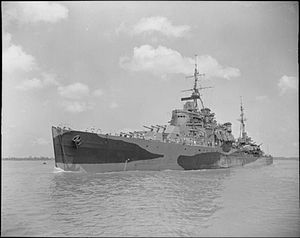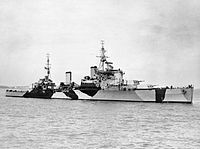- Crown Colony class cruiser
-

HMS NigeriaClass overview Name: Crown Colony Operators:  Royal Navy
Royal Navy
 Royal Canadian Navy
Royal Canadian Navy
 Indian Navy
Indian Navy
 Peruvian Navy
Peruvian NavyPreceded by: Dido class Succeeded by: Minotaur class Subclasses: Fiji
CeylonCompleted: Eleven Lost: Two General characteristics Class and type: light cruiser Displacement: 10,725 tons full load
(Ceylon class: 10,840 tons full load)Length: 555 ft 6 in (169.32 m) overall Beam: 62 ft (19 m) Draught: 16 ft 6 in (5.03 m) Propulsion: Four Admiralty 3-drum boilers
Four Parsons geared steam turbines
Four shafts
72,500 shp (54 MW)
(Ceylon group; 80,000 shp (60 MW))Speed: 31.5 knots
(Ceylon group; 32 knots)Range: 10,100 nm (18,700 km) at 12 knots (22 km/h) Complement: 730 Armament: Fijigroup: - 12 x BL 6 in (152 mm) Mark XXIII guns in 4 triple mountings Mark XXI
- 8 x QF 4 in (102 mm) Mark XVI guns in 4 twin mountings Mark XIX
- 8 x QF 2 pdr (40 mm) Mark VIII "pom-pom" in 2 quad mountings Mark VII
- 2 x triple 21 in (533 mm) tubes for torpedoes Mark IX
- 9 x BL 6 in (152 mm) Mark XXIII guns in 3 triple mountings Mark XXI
- 8 x QF 4 in (102 mm) Mark XVI guns in 4 twin mountings Mark XIX
- 12 x QF 2 pdr (40 mm) Mark VIII in 3 quad mountings Mark VII
- 2 x triple 21 in (533 mm) tubes for torpedoes Mark IX
Aircraft carried: Two Supermarine Walrus aircraft (removed by 1944, never fitted in Fiji or Kenya) The Crown Colony-class light cruisers of the Royal Navy were named after Crown Colonies of the British Empire. The first eight are known as the Fiji class, while the last three to be built are commonly referred to as the Ceylon class and were built to a slightly modified design.
Contents
Design
They were built due to the limitations that the Second London Naval Treaty imposed on cruisers, which lowered the Washington limit of 10,000 tons to 8,000 tons, and were basically smaller derivatives of the Town-class cruiser. The armour scheme was revised from that of the Towns, in that the main belt now protected the 6 inch ammunition spaces, although the belt itself was reduced to 3.5 inches here and 3.25 inches at the machinery spaces. The 6 inch Mk XXIII turrets and ammunition spaces were laid out as per the Edinburgh group of the Town class, except the after turrets were a deck lower as in the Southampton and Gloucester groups. The supply of ammunition to the 4-inch (102 mm) guns was also improved, dispensing with the complicated conveyor system. The Crown Colonys were instantly recognisable as they had a transom stern and straight funnels and masts; those of the Towns being raked. Due to the size of the Crown Colony class, a number of the ships had their 'X' turret removed to allow the shipping of additional light anti-aircraft guns. Ships of the Fiji group were equipped with the HACS AA fire control system for the secondary armament while the Ceylon group used the Fuze Keeping Clock for AA fire control and both groups used the Admiralty Fire Control Table for surface fire control of the main armament, and the Admiralty Fire Control Clock for surface fire control of the secondary armament. [1]
Modifications
The addition of radar sets meant that the aircraft were now surplus to requirements, allowing the removal of the aircraft and catapult. Not only did this provide additional accommodation spaces for enlarged wartime crews, but there was no longer the need to carry large quantities of volatile aviation fuel; in 1940, Liverpool had her bows blown off when a torpedo detonated the 5,700 gallons of aviation fuel stored forwards and was out of action for a year. Fiji and Kenya never received the catapult, Nigeria had hers removed in 1941 and the other ships had theirs removed between 1942 and 1944.
The Ceylon group were completed without 'X' 6 inch turret, and between 1944 and 1945, those of Bermuda, Jamaica, Mauritius and Kenya were also removed. This allowed the carriage of additional light A/A weapons, a quadruple QF 2 pdr pom-pom mounting Mark VII generally being carried in 'X' position. Bermuda, Jamaica and Mauritius had 2 additional quadruple pom-poms added (for a total of five) and between 2 and 4 single pom-poms in powered mountings Mark XV. In Kenya, all pom-poms were removed, and were replaced with 5 twin and 8 single 40 mm /60 Bofors A/A. By the end of the war, Newfoundland had one and Uganda had 2 American pattern quadruple 40 mm /60 Bofors mounts Mark III and Nigeria had 4 single mounts Mark III. Generally, 6 to 24 20 mm Oerlikon guns were also added in a mixture of single mounts Mark IIIA and twin powered mounts Mark V.
Service
They served with distinction during the Second World War, losing Fiji in 1941, and Trinidad the following year. They continued in service after the war, taking part in further actions, such as the Korean War. Ceylon was later sold to Peru, being renamed Coronel Bolognesi, along with Newfoundland, which was renamed Almirante Grau. The ship was decommissioned in 1982. Nigeria was also sold, to India, being renamed INS Mysore. The ship was scrapped in 1985, an astonishingly long time since her launch in the late 1930s.
All ships of the Crown Colony-class were decommissioned from the Royal Navy by the late 1960s, though none of them were the last cruisers of the Royal Navy. That honour went to Blake, a modified Tiger-class cruiser, which was decommissioned in 1980, seemingly the last ever cruiser to be in the Royal Navy.
Ships of the class
Fiji group
- Bermuda - Took part in Operation Torch, the landings in North Africa, during WWII, as well as other operations. After the war, the ship continued in service, seeing much of the world, and receiving a number of refits which helped her last until her decommissioning in 1962. She was scrapped in 1965.
- Fiji - In 1940 Fiji was torpedoed by a German U-boat but survived. In 1941, during the Battle of Crete, Fiji was hit by a bomb from a German Me 109 aircraft, after having survived 20 bomb hits, this one caused her to list heavily, though three further bombs proved fatal for the cruiser. 244 of her crew were lost.
- Gambia - Was transferred to the Royal New Zealand Navy from 1943, seeing active service in the British Pacific Fleet. She was returned to the Royal Navy in 1946. The ship was scrapped in 1968.
- Jamaica - Served in WWII, taking part in a number of operations during that war. In the Korean War, Jamaica was known as "The Galloping Ghost of the Korean Coast", due to the North Koreans claiming that she had been sunk three times. She was scrapped in 1960.
- Kenya - Was heavily involved in WWII, being deployed to the Far East for some time. Kenya was also involved in the Korean War. She was scrapped in 1962.
- Mauritius - She was involved in the Normandy Landings, and other actions during WWII. She was scrapped in 1965.
- Nigeria - Was involved in Operation Pedestal (when she was damaged by Italian submarine Axum), the largest attempt to assist the besieged island of Malta in 1942. She participated in raids on Sumatra as part of the Eastern Fleet in 1945, as well as a number of other deployments. She was sold to India in 1958, being renamed INS Mysore. She was scrapped in 1985.
- Trinidad - In 1942 while engaging three German destroyers, she was hit by her own torpedo, which had a faulty gyroscope causing it to run in circles, though she did destroy one of the German warships. The same year, Trinidad was hit by Luftwaffe Ju 88 bombers, damaging her to an extent that her crew were forced to scuttle her in the Barents Sea the following day.
Ceylon group
- Ceylon - Was deployed to the Far East for much of World War II, and was heavily involved in the Korean War, being involved heavily during that war. She was decommissioned in 1960, and subsequently sold to Peru, being renamed Coronel Bolognesi. She was decommissioned in 1982.
- Newfoundland - She was torpedoed by Malta, and full repairs at Boston Navy Yard. In 1944, the ship suffered an explosion at Alexandria while docked there. She sustaining heavy damage, also suffering a number of casualties. She was in the Far East from 1945, supporting a number of operations there. She sank the Egyptian frigate Domiat, during the Suez operations, after the latter ship fired on her. She was sold to Peru in 1959, being renamed Almirante Grau and then Capitan Quinones in 1973. She was decommissioned in 1979. She was ironically broken up in Japan, the country that she and her crew fought against in World War II.
- Uganda - Escorted the RMS Queen Mary to Washington with Winston Churchill embarked. Covered the invasion of Sicily in 1943. She was then hit by a German glide bomb that same year, causing significant damage and killing sixteen of her crew and wounding seven. Following repairs carried out in 1944 in the USA she was recommissioned in the Royal Canadian Navy as HMCS Uganda. She joined the British Pacific Fleet in 1945 taking part in a number of actions in the Far East. She was put in reserve in 1947 but recommissioned as HMCS Quebec for service in the Korean War. The ship was scrapped in 1961.
See also
References
- ^ Campbell, Naval Weapons of WWII, p.15.
Bibliography
- Colledge, J. J.; Warlow, Ben (2006) [1969]. Ships of the Royal Navy: The Complete Record of all Fighting Ships of the Royal Navy (Rev. ed.). London: Chatham. ISBN 978-1-86176-281-8. OCLC 67375475.
- Crown Colony class at Uboat.net
- WWII cruisers
External links
- Gunnery Layout of "Mauritius" Class Cruiser. from Gunnery Pocket Book 1945 placed online courtesy of Historic Naval Ships Association
Crown Colony-class cruiserFiji-group Ceylon-group Ceylon · Newfoundland · Uganda
Capitán Quiñones (ex-Newfoundland) · Coronel Bolognesi (ex-Ceylon)
Categories:- Cruiser classes
- Crown Colony class cruisers
Wikimedia Foundation. 2010.

